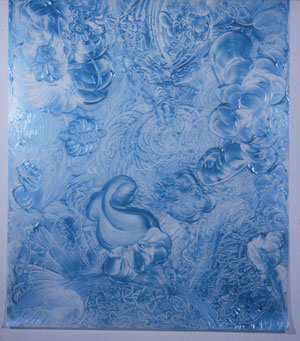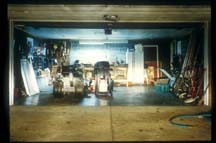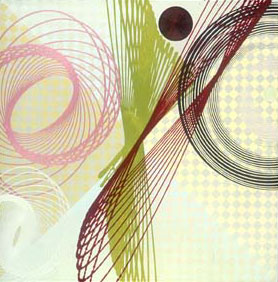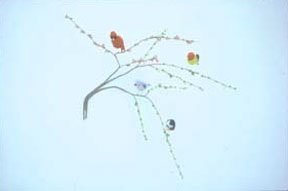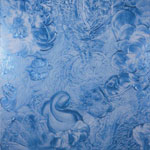More than half of the newly Americanized and/or newly talented artists featured in this year’s Texas Fine Art Association exhibition of New American Talent are over 35 years of age. Only six of the 36 artists represented are under 30 years old. As someone who is over 35, I find it reassuring to have demonstrated to me that talent can come anew at what used to be a ripe age.
With 36 artists and more than 50 works of art, this is a sprawling show. Kathryn Kanjo, executive director of San Antonio’s ArtPace, juried the exhibition. Her tastes for the show seem to include a finish fetish, baroque detailing and an inclusiveness for new and traditional media (with the exception of big, heavy sculptural pieces). Because of the size of the show, it would be tedious for me to try to mention all of the works on display, or even all of the artists. So I won”t try.
Estevan Arredondo’s well-controlled application of oil and pigment on Mylar stands out for its excellence. Seeing Is Believing is a shot of response to the ‘superflat” trend in finish fetish art. This painting has an immense amount of visual depth due to its proportion of shapes and varying densities of pigment. Its luscious, iridescent oil/pigment mixture is set off by sharp white negative spaces, the effect of which is like futuristic cinematography for a Phil Dick adaptation. The flowering shapes of the foreground have an ethereal quality that grounds the painting, even as they appear to float away. This combination of crispness and haziness makes the painting thoroughly engaging both close up and across the room. I found myself delving deeper and deeper into Seeing Is Believing’s visual recesses, and felt like I could almost ‘see around the corner.” As I tried to walk away, I found myself drawn back into it. BRAVO. Arredondo has used commercial materials to fresh and vital effect.
Erika Lepmann shows two large, technically superb, documentary-style photographs.Titled Arriving Home — one is subtitled 5236 Rock Rifle Road, the other 2242 East State Road — Lepmann’s images have captured the beauty of quotidian elements. They call attention to the rich color palette of everyday consumerism that most of us take for granted. High commerce offers such a plentiful variety of colors and shapes that happenstance abstract compositions in jamb-packed cabinets and cluttered garages are part of our daily lives. This makes difficult work for the art structuralist who wishes to stand apart from the daily. Lepmann has given in. Lighted by car headlights and fluorescent tubes, with seemingly minimal equipment or intrusion, Erika Lepmann has captured the beauty of the suburbanite’s habitat.
Terri Bright offers her own version of the photo-documentary with two pieces subtitled From The Cuba Series. These images are from mid-century Cuban haunts where aristocrats smoked cigars and shuffled their feet. But they could be interchangeable with many buildings leftover in small American cities from the same time period. A corner, two walls meet, a lamp hangs down, the base of a staircase — these photographs don’t have the conceptual depth of Lepmann’s. Instead, they attempt to capture the mood of beauty having matured and — by dint of neglect — decayed. As such, Bright’s photos address formally the quotidian that Lepmann exposed in concept.
Dean Eliasen’s paintings Going Together and Trajectory place overlapping circles of lustrous acrylic on checked backgrounds. Eliasen then welds the fore and backgrounds together by periodically reversing the positive and negative spaces. These designs could be graphs of gravitational well pools for planetary bodies. Both paintings emit a cosmic vibe, not only from the spherical bodies on the canvases, but also from the sparkling grooviness of the paint. The echoing circles harken back to shapes produced with the Spirograph set I toyed with as a kid. While some may find this playful, I found it superficial. Ultimately, I was as easily distracted from the paintings as I was from the Spirograph toy.
The object of my distraction in this instance was Sarah Emerson’s Goodbye Iowa. This sparkling, circular piece is like looking through a telescope at an underdeveloped, bucolic side-thought in the artist’s mind. Splotchy rhinestone flowers drift away from their rhinestone stems, out of a rhinestone field, to stain a perfectly blue rhinestone sky like colorful rhinestone clouds. Intended(?) slippage in the rhinestone application provides brushstroke-like gaps in the mosaic. This adds a layer of personality to the piece, and personality is as much what Emerson’s work is about as anything else. Her other exhibited piece, Feeding The Kitty, displays similar conceptual drive but utilizes entirely different materials. It’s a cloyingly prosaic sculpture of pipe-cleaner tree branches and plastic flowerbuds, with a flock of yarn birdies adorning it. Feeding the Kitty has nicely undermined sentimentality, provided by the title. While this artwork might get lost in Auntie Olivia’s parlor, those who know the title can still be in on the joke.
In the back gallery, I was confused by Jacqueline Ehlis” Swerve And Glitter. This piece has two components: a crude drawing on a square birch panel, and a highly fetishized plastic semi-orb. The orb resembles a surveillance dome darkened by glittery, opaque paint. Together with the drawing panel, the two are profoundly awkward. They are complete opposites in such a way that they don’t contrast each other so much as repel one another. Even the spacing between the two promotes optimal awkwardness.
Aimee Rhodes Cook’s ink jet prints provide narrow glimpses of intimate public contact. The prints” grainy quality and rich varnished surface have the seductive allure of a burgeoning medium that is sure to catch on.
This year’s New American Talent has provided us with two sets of videos. The two couldn’t be more different. Gail Dawson’s Bird Animation is a compilation of digitized painting and drawings that allow a bird to take flight in the same way that compiled still photos make a motion picture. The drawings have a wispy expressive quality that, when coupled, create the melancholy tone of observing nature through a frosted window. Fluid and tranquil, Bird Animation is a tight composition. On the other hand, Less Than Nothing, by Travis Lindquist, is a politically charged “home video” that pounds viewers over the head with socially active text, while bombarding them with technical crudeness. The camera work is tedious, emphasizing the video’s aggressive contempt. All of the shots are from similar psychic distances; and the editing is rough, seeming to rely heavily on stock tools of Premier, the video-editing software. Less Than Nothing’s blathering, rolling text is used more as a crutch than a stylistic embellishment. The video runs back to back with two other shorts: Mundane Moments of the Dispossessed, and The Biggest Mistake. I didn’t view them.
A rash of pattern paintings of above-standard technical attention line the walls of both main rooms. I estimate that the life of this micro-movement is on the wane. The paintings, although by various artist’s, all seem to bleed together. The idea of art as wallpaper is well matured, and I look forward to the progression of the statement. There are a few exceptions to the wallpaper such as Vincent Valdez’s portrait Yo” Soy-ee Blaxican. Valdez continues the tradition of Hispanic art that began with the Mexican Muralist Movement by using dark rich colors to flesh out the people and signs — and by extension, the socio-political structure — of our time. Another exception is Owen McAuley’s Steps, which captures the warm light of a parking garage cutting through the night air in a style reminiscent of Edward Hopper.
Images courtesy the artists and TFAA.
Michael Stewart is a new American talent getting older by the day, daily.


